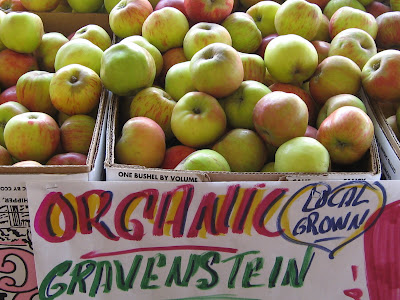Beans are an excellent vegetarian source of protein.

But Where do you Get Your Protein?
This is probably the most frequent and annoying question posted to vegetarians. It is a myth that a vegan and vegetarian diet is deficient in high quality protein. Vegetarians can easily get their daily requirements by eating a variety of foods high in plant proteins (see "Examples of Protein Content in Common Foods" listed below). Lacto-ovo vegetarians get additional protein from eating dairy and eggs.
How Much Protein do we Need?
The Recommended Daily Allowance (RDA) is 0.8 grams per kilogram, or 0.36 grams per pound, of adult body weight. According to this, a 130 pound female would need about 47 grams of protein per day. A 180 pound man would need about 65 grams. Since unprocessed plant proteins are slightly less digestible, the recommended protein intake for vegans whose diet is mostly from whole foods like grains, beans and vegetables, is 0.9 grams per kilogram, or 0.4 grams per pound. This uplift is not necessary if their diet includes tofu or meat substitutes which are highly digestible. Protein requirements increase during periods of growth and for pregnant and lactating women.
Can we get Too Much Protein?
The short answer to this question is yes. Eating too much protein causes a build up of ketones. This causes the kidneys to work extra hard to remove these toxic ketones putting undue strain on the kidneys. This also causes excess loss of water and calcium. Studies show that excess plant protein results in less kidney damage that excess protein from meat or milk.
As you can see from the list below, it is easy to consume excess protein if you are a meat eater. A few eggs in the morning, a cheese burger for lunch and a 6 ounce chicken breast for dinner would add up to over 100 grams of protein without even counting the protein obtained from the other grains or veggies eaten along with it. This is more than double the requirements for a 130 pound female. I shutter to think what the popular high protein Atkins diet has done to people's long term health. For a remarkable book that discloses the implications of a diet high in protein and fat, read "The China Study" by T. Colin Campbell and Thomas M. Campbell II. I believe it's one of the most important books ever written about nutrition and health.
A vegetarian or vegan who eats grains, tofu, nuts and beans can easily meet their daily requirements for protein. I do feel, however, that raw food vegans will have to make sure they are sprouting beans and grains and eating enough nuts and seeds to get sufficient protein.
Personally, I feel the healthiest diet consists of lots of raw fruits and vegetables, some cooked grains and beans, some goat yogurt and an occasional egg or fish dish.
Examples of Vegetarian and Non-Vegetarian Protein Sources
[Sources, nutrtiondata.com and manufacturers information]
Vegetables
• 1 cup raw broccoli, 3 g
• 1 cup raw kale, 2 g
• 1 medium baked potato, 3 g
• 1 large ear of corn, 5 g
• 1 cup cooked white mushrooms, 4 g
• 1 cup grilled Portobello mushrooms, 5 g
• 1 cup cooked spinach, 5 g
Legumes
• 1 cup cooked garbanzo beans, 14 g
• 1 cup red kidney beans, 17 g
• 1 cup cooked lentils, 18 g
• 1 cup raw sprouted lentils, 7 g
•1 cup cooked soybeans, 22 g
• 3 oz. extra firm tofu, 9 g
Eggs, Dairy and Nondairy Milk
• 1 oz. cheddar cheese, 7 g
• 1/2 cup low fat cottage cheese, 13.5 g
• 1 hard boiled egg, 6 g
• 1 cup 2% milk, 8 g
• 1 cup low fat yogurt, 13 g
• 1 cup Silk plain soy milk, 7 g
• 1 cup Hemp Bliss original flavor hemp milk, 5 g
• 1 cup Rice Dream rice milk, 1 g
Nuts, Nut Butters and Seeds
• 1 oz. almonds, 6 g
• 1 oz. pine nuts, 4 g
• 1 oz. walnuts, 4 g
• 2 tablespoons chia seeds, 4 g
• 2 tablespoons whole flax seeds, 4 g
• 2 tablespoons Nutiva hemp seeds, 11 g
• 1 oz. pumpkin seeds, 7 g
• 1 oz. sunflower seeds, 6 g
• 2 tablespoons raw almond butter, 7 g
• 2 tablespoons smooth peanut butter, 7 g
• 2 tablespoons raw sesame tahini, 6 g
Grains and Grain Products
• 1/2 cup cooked pearl barley, 2 g
• 1/2 cup cooked oatmeal, 3 g
• 1/2 cup cooked quinoa, 4 g
• 1/2 cup cooked brown rice, 2.5 g
• 1/2 cup cooked white rice, 2 g
• 1/4 cup whole wheat flour, 4 g
• 2 oz. cooked whole grain pasta, 7 g
• 1 cup sprouted wheat, 8 g
Fruits
• 1/4 cup dried apricots, 3 g
• 1 large apple, 1 g
• 1 avocado, 3 g
• 1 medium banana, 1 g
• 1 cup blueberries, 1 g
• 1 medium orange, 1 g
• 1/4 cup raisins, 1.5 g
Beef, Poultry and Seafood
• 3 oz. 85% lean ground beef, 22 g
• 3 oz. roasted chicken breast, 27 g
• 3 oz. canned light tuna fish, 22 g
• 3 oz. wild Atlantic salmon, 22 g







































